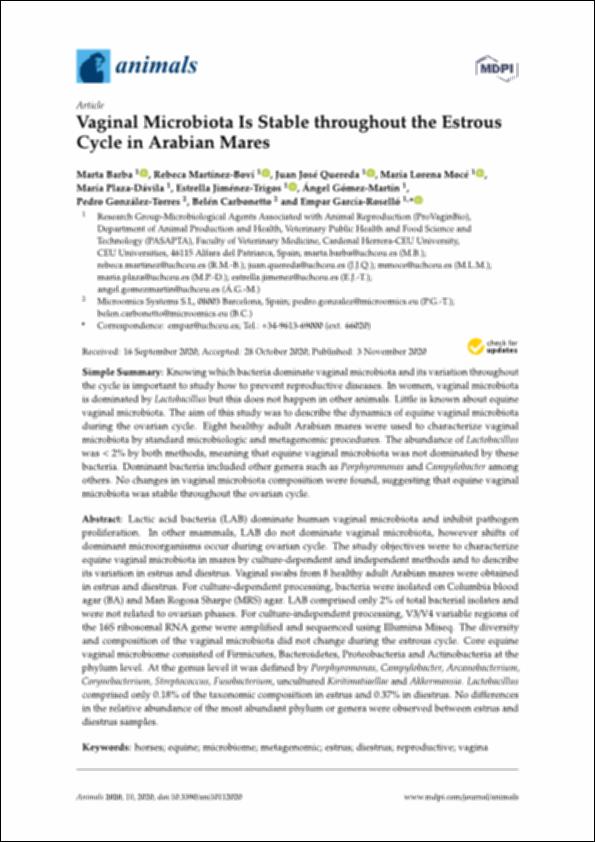Por favor, use este identificador para citar o enlazar este ítem:
http://hdl.handle.net/10637/12479Vaginal microbiota is stable throughout the estrous cycle in Arabian mares
| Título : | Vaginal microbiota is stable throughout the estrous cycle in Arabian mares |
| Autor : | Barba Recreo, Marta Martínez Boví, Rebeca Quereda Torres, Juan José Mocé Cervera, María Lorena Plaza Dávila, María Jiménez Trigos, María Estrella Gómez Martín, Ángel García Roselló, Empar |
| Materias: | Bacteriología veterinaria.; Veterinary bacteriology.; Estro.; Caballos - Razas - Árabe - Reproducción.; Horse breeds - Arabian - Generative organs.; Horse breeds - Arabian - Reproduction.; Caballos - Razas - Árabe - Aparato genital.; Estrus. |
| Editorial : | MDPI. |
| Citación : | Barba, M., Martínez-Boví, R., Quereda, J.J., Mocé, M.L., Plaza-Dávila, M., Jiménez-Trigos, E., et al. (2020). Vaginal microbiota is stable throughout the estrous cycle in Arabian mares. Animals, vol. 10, i. 11 (03 nov.), art. 2020. DOI: https://doi.org/10.3390/ani10112020 |
| Resumen : | Lactic acid bacteria (LAB) dominate human vaginal microbiota and inhibit pathogen proliferation. In other mammals, LAB do not dominate vaginal microbiota, however shifts of dominant microorganisms occur during ovarian cycle. The study objectives were to characterize equine vaginal microbiota in mares by culture-dependent and independent methods and to describe its variation in estrus and diestrus. Vaginal swabs from 8 healthy adult Arabian mares were obtained in estrus and diestrus. For culture-dependent processing, bacteria were isolated on Columbia blood agar (BA) and Man Rogosa Sharpe (MRS) agar. LAB comprised only 2% of total bacterial isolates and were not related to ovarian phases. For culture-independent processing, V3/V4 variable regions of the 16S ribosomal RNA gene were amplified and sequenced using Illumina Miseq. The diversity and composition of the vaginal microbiota did not change during the estrous cycle. Core equine vaginal microbiome consisted of Firmicutes, Bacteroidetes, Proteobacteria and Actinobacteria at the phylum level. At the genus level it was defined by Porphyromonas, Campylobacter, Arcanobacterium, Corynebacterium, Streptococcus, Fusobacterium, uncultured Kiritimatiaellae and Akkermansia. Lactobacillus comprised only 0.18% of the taxonomic composition in estrus and 0.37% in diestrus. No di erences in the relative abundance of the most abundant phylum or genera were observed between estrus and diestrus samples. |
| Descripción : | Este artículo se encuentra disponible en la siguiente URL: https://www.mdpi.com/2076-2615/10/11/2020 En esta investigación también participan: Pedro González-Torres y Belén Carbonetto. Este artículo pertenece al número especial "Veterinary endocrinology and reproduction in the mare". |
| URI : | http://hdl.handle.net/10637/12479 |
| Derechos: | http://creativecommons.org/licenses/by/4.0/deed.es |
| ISSN : | 2076-2615 (Electrónico). |
| Fecha de publicación : | 3-nov-2020 |
| Centro : | Universidad Cardenal Herrera-CEU |
| Aparece en las colecciones: | Dpto. Medicina y Cirugía Animal |
Los ítems de DSpace están protegidos por copyright, con todos los derechos reservados, a menos que se indique lo contrario.


